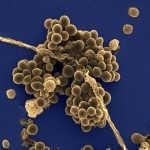Link to Pubmed [PMID] – 1605611
Antimicrob. Agents Chemother. 1992 Feb;36(2):463-6
The genetic basis of tetracycline resistance was studied in 25 clinical isolates of Listeria monocytogenes. Resistance to tetracycline was associated with resistance to minocycline and due to the presence of the tet(M) gene in 24 strains. Association of tet(M) with int-Tn, the gene encoding the protein required for the movements of Tn1545-like conjugative transposons, was found in all strains. Cotransfer of tet(M) and int-Tn among L. monocytogenes cells and from L. monocytogenes to Enterococcus faecalis was detected in 7 of the 12 strains studied at frequencies similar to those obtained with the prototype element Tn1545. tet(L), the second most prevalent tetracycline resistance gene in enterococci and streptococci, was detected in the remaining strain, where it was borne by a 5-kb plasmid. These observations indicate that two types of movable genetic elements, transposons and plasmids, in enterococci and streptococci are responsible for emergence of drug resistance in L. monocytogenes.

